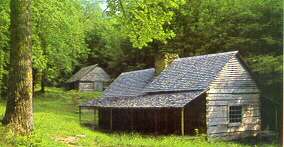Echoes From The Past
By JUDY MAUPIN
*- Echoes From the Past
(A Column of historical and genealogical anecdotes, stories and family notes.)
Calloway County, Ky.
Thomas Migration To Kentucky - Part III
no date
"When James Thomas and his family arrived there to spend the night in the spring of 1806, the new Crab Orchard tavern was about four years old. The travelers camped outside, but the menfolk of the families usually gathered at the tavern for an evening of relaxation and talk before bedding down for the night. The tavern became a well-known stopping place and visitors included President Andrew Jackson during his tenure as president of the United States on his trips between Washington and his home at the Hermitage near Nashville. The old inn stood until 1925.
"The Walton Road continued west through Crossville, so named later because it crossed another of the early day routes at that point. Today it is the county seat of Cumberland County. From there the road led to Standing Rock (now Monterey) named for a large, conspicuous outcropping of stone, a landmark visible to travelers for many miles. The road passed through Cookeville, a point almost in the heart of the Cumberland Plateau, a tableland nearly as level as a western prairie. At that time, however, it was heavily wooded with the vast forests of virgin timber.
"From Cookeville it was downhill most of the way to the Cumberland River. The road veered slightly north in order to avoid having to cross the rather sizable Caney Fork River that emptied into the Cumberland just upstream from the settlement of Carthage. There, emigrants bound for the areas north of Nashville, both in Tennessee and Kentucky, were ferried across the Cumberland to continue their journey overland. Settlers headed for Fort Nashboro, usually crossed the Caney Fork River and continued along the road south of the Cumberland via Lebanon in Wilson County. Some settlers obtained flatboats either at Carthage or Fort Nashboro, and floated down the Cumberland to their property. One Kentucky-bound family, the Futrells of Northampton County, North Carolina, came down the Cumberland by flatboat but missed the mouth of Donaldson Creek and landed at Boyd's Landing, not Canton, instead.
In Smith County, Tennessee, James and Mary Thomas very likely stopped to visit with James' sister Sarah, who
o lived on Goose Creek.
After a visit of several days during which time the family rested from their ordeal, James Thomas and his family resumed their journey. From Smith County the comparatively easy trail led to Gallatin and Springfield, Tennesse
to Hopkinsville, in Christian County, Kentucky. After resting there, they left on the final lap of the long trek - the remaining 20 miles to Donaldson Creek, his new home.
The secluded valley in which James Thomas II settled, begins at the extreme western edge of an area of Kentucky known as the Barrens, some eight miles east of the Cumberland River. It lies between wooded hills that range up to 700 feet above sea level, and runs almost due west. Physically, the valley has an almost level floor, which
at the head is about 460 feet above sea level, and in its westward course, drops to about 350 feet at the point where the creek empties into the eastern bank of the Cumberland River. It varies in width from about a quarter of a mile to almost a mile near the river.
The first residents in the Donaldson Creek valley entered by a trail that led from the Barrens at a point a few miles from what is now the line that divides Christian and Trigg Counties, down a winding half-mile long hill to the valley floor.
The sight they saw must have been one of welcome relief, for, as one account put it, there were no trees, shrubbery, or undergrowth of any kind across the Barrens between Donaldson Creek and Hopkinsville big enough from which to "obtain a riding switch." Believing that the Barrens would never be worth anything because the land would not grow trees, early settlers sought the more secluded areas along the Donaldson Creek valley where there were springs, a perpetual stream teeming with fish, and forests full of wild game and towering trees suitable for building cabins and other structures so necessary for the pursuit and protection of life in the wilderness. As it turned out, however, much of the Barrens ultimately was converted into some of the best farmland in Kentucky outside of the Bluegrass.
"As time passed, other settlers learned of the rich area along Donaldson Creek and its tributaries and came in increasing numbers with each family being able to locate comfortably at various points along its forested length. In time, too, they would clear land up into the hills and some even staked out claims on the thin-sloiled, less productive high ridges both to the north and to the south."
So it was that one of Western Kentucky's earliest and most productive families camb from their home in North Carolina and started the migration which resulted in what is Trigg County today.
~ -

